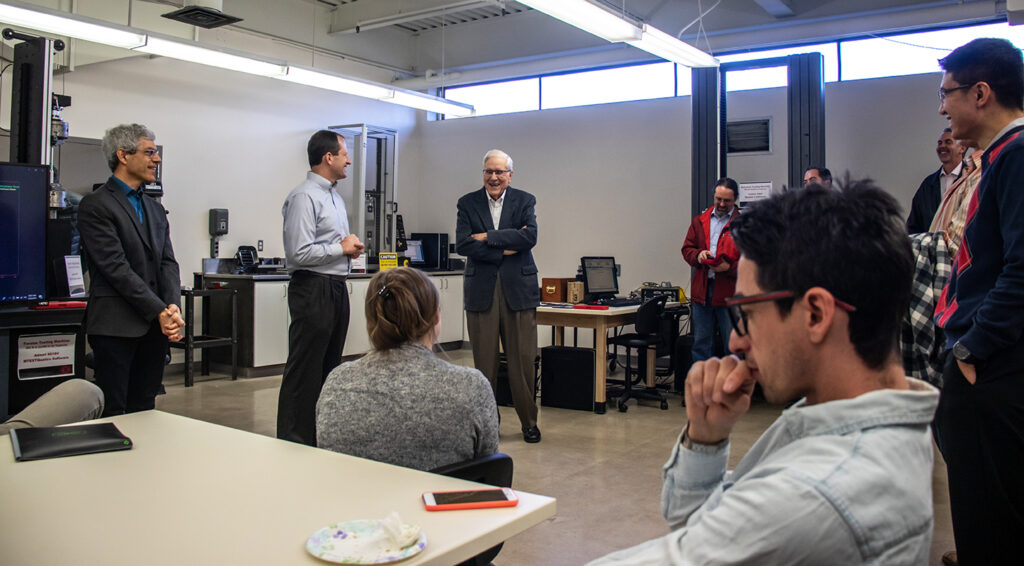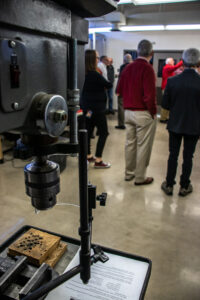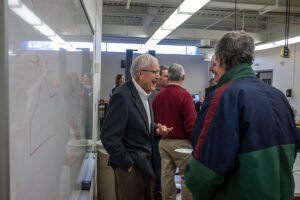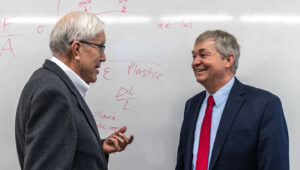The University of Utah College of Engineering, the Department of Mechanical Engineering, family, and friends gathered to dedicate the Kay and Larry DeVries Strength of Materials Laboratory (1186 Merrill Engineering Building) Friday, January 25. It was professor DeVries’ vision to have a laboratory in which small groups of students could have a hands-on experience, focusing on topics that they were learning about in the classroom, and using modern equipment. It’s taken a number of years for it to become a reality for our students, and the Kay and Larry DeVries Strength of Materials Laboratory has become just that!
In it, mechanical tests are done for tension, buckling, twisting and more, all in an effort to characterize the strength of materials. The lab was recently refurbished with new floors, ceilings, tables, chairs and a television monitor for lectures. It also has been steadily receiving new material testing systems. In addition to DeVries, speakers at the dedication included U mechanical engineering Chair Bruce Gale, mechanical engineering professor Dan Adams and department mechanical engineer Jeff Kessler.
 The story and development of the Kay and Larry DeVries Strength of Materials Laboratory goes back at least 20 years – back to the time when the University of Utah was on quarters (not semesters). At the time, there was a stand-alone one-quarter strength of materials lab class that our students took. Ironically there wasn’t a laboratory dedicated to this lab class, so mechanical engineering professor Larry DeVries allowed students to use the testing equipment in his research laboratory. The laboratory was more of a demonstration of lab procedures and tests, without a lot of hands-on.
The story and development of the Kay and Larry DeVries Strength of Materials Laboratory goes back at least 20 years – back to the time when the University of Utah was on quarters (not semesters). At the time, there was a stand-alone one-quarter strength of materials lab class that our students took. Ironically there wasn’t a laboratory dedicated to this lab class, so mechanical engineering professor Larry DeVries allowed students to use the testing equipment in his research laboratory. The laboratory was more of a demonstration of lab procedures and tests, without a lot of hands-on.
 Mechanical engineering professor Dan Adams told the group gathered for the lab dedication, “Transitioning to semesters changed everything. We had the opportunity to redesign our curriculum, which is when Larry took the lead in developing a hands-on, small student-group laboratory environment. It was part of and integrated into the strength of materials course. A series of laboratory experiments were developed, and the lab sections were designed for 12 students, divided into three groups of four. Under the supervision of a lab teaching assistant, the small student groups rotated through the three experiments, one per week. This allowed for three lab experiments going on at the same time, each with four students, providing an extremely hands-on approach to the laboratory. It was a hit, and became the most highly rated lab experience in the department – based on student evaluations and exit interviews.”
Mechanical engineering professor Dan Adams told the group gathered for the lab dedication, “Transitioning to semesters changed everything. We had the opportunity to redesign our curriculum, which is when Larry took the lead in developing a hands-on, small student-group laboratory environment. It was part of and integrated into the strength of materials course. A series of laboratory experiments were developed, and the lab sections were designed for 12 students, divided into three groups of four. Under the supervision of a lab teaching assistant, the small student groups rotated through the three experiments, one per week. This allowed for three lab experiments going on at the same time, each with four students, providing an extremely hands-on approach to the laboratory. It was a hit, and became the most highly rated lab experience in the department – based on student evaluations and exit interviews.”
 “Larry was also instrumental in procuring modern lab equipment for the laboratory,” continued Adams. “Originally we started by acquiring old lab equipment and having it refurbished, getting items from the University of Utah surplus center, etc. As time went on, we were able to begin attaining more modern testing equipment, through the BEEF grant program. He was the principal investigator on virtually every one of these BEEF grants.”
“Larry was also instrumental in procuring modern lab equipment for the laboratory,” continued Adams. “Originally we started by acquiring old lab equipment and having it refurbished, getting items from the University of Utah surplus center, etc. As time went on, we were able to begin attaining more modern testing equipment, through the BEEF grant program. He was the principal investigator on virtually every one of these BEEF grants.”
Jeff Kessler, who is a mechanical engineer in the department and runs the lab said, “Today, students turn to Google, Bing, Yahoo, or other searches when they have a question. I use professor DeVries – especially when it comes to solid mechanics questions. He either knows the answer or he knows where to find it in one of his books. On the rare occasion when he didn’t know the answer he would grab a scrap of paper and start drawing a free-body diagram using equations of Newton derived solutions, and find the answer.”
 DeVries earned his bachelor’s in mechanical engineering in 1959 and a doctorate in physics and mechanical engineering in 1962, both from the University of Utah. He joined the mechanical engineering faculty at the U that same year. Since then, he has served in several different positions including assistant professor, distinguished professor, president of the academic senate, as well as senior associate and acting dean of the college before retiring. Click here to read more about his illustrious career.
DeVries earned his bachelor’s in mechanical engineering in 1959 and a doctorate in physics and mechanical engineering in 1962, both from the University of Utah. He joined the mechanical engineering faculty at the U that same year. Since then, he has served in several different positions including assistant professor, distinguished professor, president of the academic senate, as well as senior associate and acting dean of the college before retiring. Click here to read more about his illustrious career.